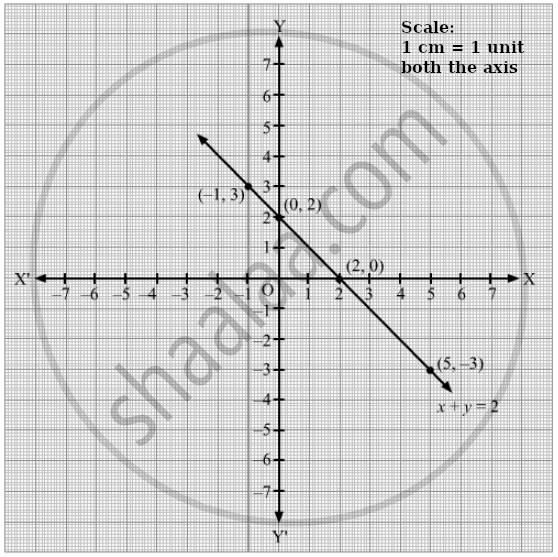Advertisements
Advertisements
प्रश्न
Draw the graph of the equation given below.
x + y = 2
उत्तर
The equation of the given line is x + y = 2.
x + y = 2
⇒ y = 2 − x ...(1)
Putting x = 0 in (1), we get
y = 2 − 0
y = 2
Putting x = 2 in (1), we get
y = 2 − 2
y = 0
Putting x = −1 in (1), we get
y = 2 − (−1)
y = 2 + 1
y = 3
Putting x = 5 in (1), we get
y = 2 − 5
y = −3
These values can be represented in the table in the form of ordered pairs as follows:
| x | 0 | 2 | -1 | 5 |
| y | 2 | 0 | 3 | -3 |
| (x, y) | (0, 2) | (2, 0) | (-1, 3) | (5, -3) |

The line is the graph of the equation x + y = 2.
APPEARS IN
संबंधित प्रश्न
The following distribution gives the daily income of 50 workers of a factory.
| Daily income (in ₹) | 200-220 | 220-240 | 240-260 | 260-280 | 280-300 |
| Number of workers | 12 | 14 | 8 | 6 | 10 |
Convert the distribution above to a 'less than type' cumulative frequency distribution and draw its ogive.
Draw the graph for the linear equation given below:
y + 6 = 0
Draw the graph for the linear equation given below:
y = 0
Draw the graph for the linear equation given below:
y = - 2x
Draw the graph for the linear equation given below:
2x - 3y = 4
Draw the graph for the linear equation given below:
x - 3 = `(2)/(5)(y + 1)`
For the pair of linear equations given below, draw graphs and then state, whether the lines drawn are parallel or perpendicular to each other.
2x - 3y = 6
`x/(2) + y/(3) = 1`
Draw the graph of equation `x/(4) + y/(5) = 1` Use the graph drawn to find:
(i) x1, the value of x, when y = 10
(ii) y1, the value of y, when x = 8.
Draw a graph of each of the following equations: 3x - 2y = 6
Draw a graph of each of the following equations: y = `(5)/(2) xx + (2)/(5)`
